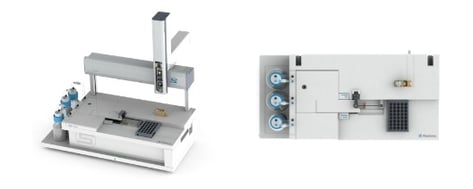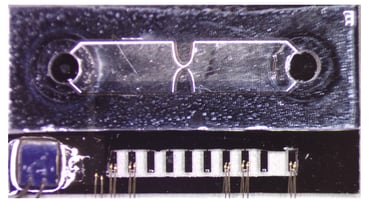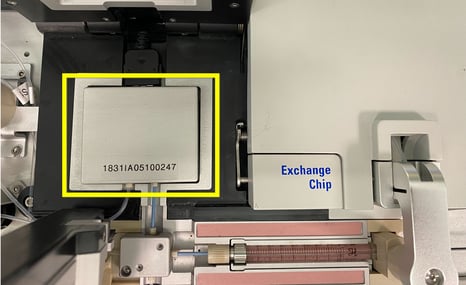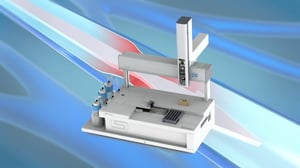We are excited to announce that you are now able to run extensional viscosity measurements on the VROC initium one plus automated viscometer!
Extensional, or elongational, viscosity is defined as the resistance of a fluid to extensional flow (flow through a field involving a change in cross-sectional area). This is different from dynamic viscosity, which measures the relationship of viscosity versus shear rate. RheoSense viscometers are powered by our patented VROC® (Viscometer-Rheometer-on-a-Chip) technology, combining microfluidic and MEMS (Micro-Electro-Mechanical Systems) technologies to measure dynamic viscosity over a wide range of operation.
Extensional viscosity is ideal for studying the complex properties of many fluids used in industrial applications. Because extensional flows greatly impact the behavior of polymer molecules and asymmetric particles, understanding extensional viscosity allows you to improve your industrial processes.
The VROC® initium one plus is the leading automatic, high throughput viscometer. The VROC initium one plus includes an intuitive software that allows automatic testing, which allows you to "set and forget" your viscosity measurements. This greatly increasing efficiency and saves expert and professional labor for your most valuable work instead of setting up and running the sample testing. 
While the extensional viscosity application may seem like a simple update for our VROC initium one plus, it was no simple feat to accomplish. To run extensional measurements on the automated instrument requires not only the use of an extensional chip, but also programming different calculations into the software, and developing new cleaning protocols. Our automated software is customized to calculate dynamic viscosity and extensional calculations require vastly different parameters and equations.

VROC® microfluidic flow channels are available with either a uniform cross-section for steady shear viscosity measurement or a centrally located hyperbolic contraction-expansion for extensional viscosity estimation. A uniform VROC® cell reads viscosity by measuring the pressure drop as a test liquid flows through its rectangular slit microfluidic channel, based on Hagen–Poiseuille flow. The measured pressure as a function of position should be linear as shown in the graph if a fully developed flow is ensured in the rectangular slit channel.

For non-Newtonian liquids the apparent shear rate does not equal the true shear rate. For the rectangular slit flow, the true shear rate is calculated by applying the rigorous Weissenberg-Rabinowitsch Correction. To ensure accuracy, our software applies this correction for non-Newtonian measurements:

**DEEP DIVE: Read more about VROC principle of Operation and the detailed equations used to calculate viscosity here.**
When measuring extensional viscosity, you must account for the apparent extensional rate (εc) as well as the pressure drop across the hyperbolic contraction-expansion cross sectional area (ΔPc(dPC)).

**DEEP DIVE: Learn more about extensional viscosity measurement theory and practice here.**
In our new application note, the viscosity of guar gum in solution was measured as a function of shear rate with the VROC® initium to demonstrate the ability of the automated viscometer to consistently load and measure the highly shear thinning formulations common utilized in the food industry.

We have also updated our cleaning protocols and diagnostics when measuring extensional viscosity on the VROC initium one plus. The VROC extensional chip has a contraction point on the center of the chip, making it difficult to clean with the traditional cleaning protocols with higher viscous samples. To ensure chips are clean after measurements, we have implemented a soak time into the cleaning protocol, allowing the sample in the contraction and expansion zones to loosen up. We have also created a reverse flow path, designed to push solvent into the chip forward and backwards, allowing the chip to be cleaned thoroughly from both sides of the contraction.
Standard diagnostics for the VROC initium one plus are based on R2 values, which check for linear sensor behavior to verify the system is producing accurate measurements. When measuring extensional viscosity, the diagnostics system is programmed to account for the pressure drop across the hyperbolic contraction-expansion cross sectional area as it assesses measurement accuracy.
With all these different features, you may be worried that you will be running the wrong calculations or diagnostics for your samples, but fear not! The new software is intuitively designed to run calculations, cleaning protocols and diagnostics based on what chip is plugged into your VROC initium one plus! To access the extensional settings you must have an extensional chip plugged into the viscometer, ensuring our guaranteed accuracy for both your dynamic and extensional automated viscosity measurements!

Want to learn more about the VROC initium one plus, or specifically how you can automate your extensional viscosity measurements with this viscometer? Contact us today to speak with one of our rheology experts!
Written by: Sid Kolhatkar, RheoSense Engineer I & Eden Reid, RheoSense Senior Marketing & Sales Operations


COMMENTS